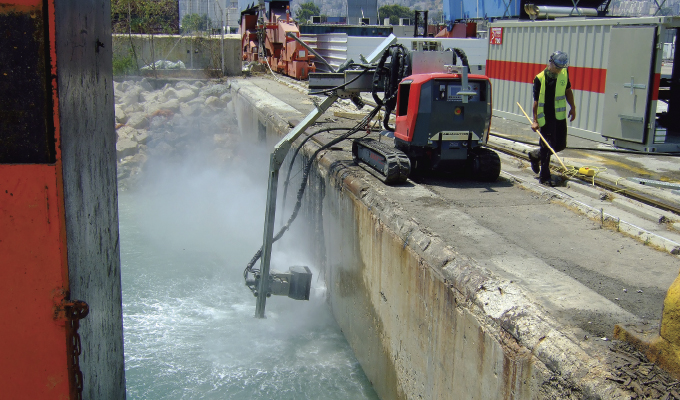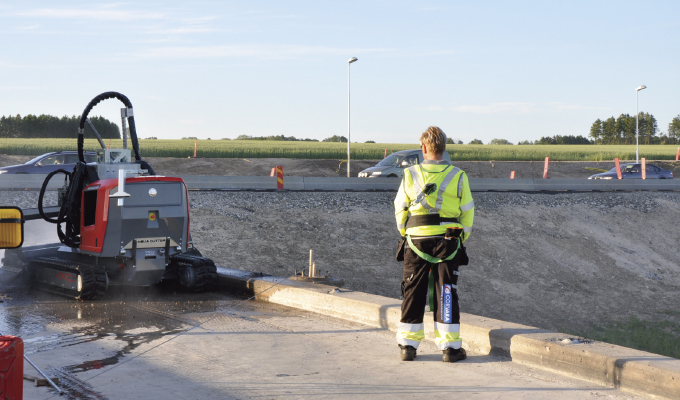Remote-controlled robots
By Shawn Kirkpatrick
Hydrodemolition robots are quickly growing in popularity as an effective and speedy method of concrete removal for repair and renovation. The remote-controlled robots also help keep the operator out of harm’s way. However, hydrodemolition robots, like all equipment, require careful operation to avoid accidents. Here are a few of the most important safety points to remember when operating a hydrodemolition robot.
OPERATE SAFELY
No one except the operator should be within 35 feet of the machine during operation. The operator should stand at least 3.2 feet away, staying constantly aware of the water jets. Also, be sure to wear a helmet, ear protection, safety glasses, face protection, steel-toed boots, gloves, and safety jacket and pants. It’s important to remember that even protective clothing will not shield from direct contact with a high-pressure jet. In case of injury, seek medical attention immediately.
While some machines include an auto function that allows the robot to run without constant operator input, the equipment and remote should never be left unattended.
NEVER WORK ALONE
One operator easily controls a single hydrodemolition robot, but there should be at least one other worker, a spotter, watching for safety hazards and monitoring other equipment. The second person can also quickly come to the operator’s aid if there’s an accident.
WATCH EQUIPMENT CAREFULLY
The spotter is also watching the pump and water hose for safety hazards. For example, if the robot malfunctions and stops moving yet continues to shoot water, it will eventually break through the surface. In this situation, the second worker can stop the water flow by shutting off the pump. To speed up the process, look for a robot operated with a remote that includes a pump shutdown option.
The water hose is the other thing to watch. As a result of the high pressure even small leaks will shoot out of the hose at a similar velocity to water out of the robot. This could mean serious injury to anyone caught in the stream. In an effort to avoid these accidents, some robots will automatically shut down if pressure starts to drop. Contractors can check for hose leaks with a piece of wood or other material, but never with their hands.

BE MINDFUL OF OTHER SIDE
Block off the other side of a surface before operation. The high-pressure water can carry debris for some distance at high speeds if the water jets break through to the other side. Also turn off, secure or avoid any utilities within the concrete to prevent damage from the water jets.
INSTALL SAFETY BARRIERS
Most hydrodemolition robots feature heavy-duty rubber shields around the cutting head, but broken concrete still occasionally escapes, sometimes flying long distances at high speeds. Contractors should block off a minimum of 82 feet around the machine with plywood barriers and install warning signs. High-strength netting can also be installed around the robot.
Contractors should also install protective barriers around the water hose at connection points and in areas open to pedestrians or cars. Replace hoses when the outer cover is worn or damaged and do not lay hoses on sharp objects.
CLOSING STATEMENT
Make sure to read a hydrodemolition robot’s operating manual before use. In addition, look for training courses offered by some manufacturers to improve jobsite safety, efficiency, and quality of work.
About the author
Shawn Kirkpatrick is the service and application specialist for the U.S. distributor of Aquajet Systems AB, Brokk Inc. He provides customers with technical support service before and after the sale for both Aquajet hydrodemolition robots and Brokk demolition machines. For more, visit www.aquajet.se.
Modern Contractor Solutions, October 2019
Did you enjoy this article?
Subscribe to the FREE Digital Edition of Modern Contractor Solutions magazine.



